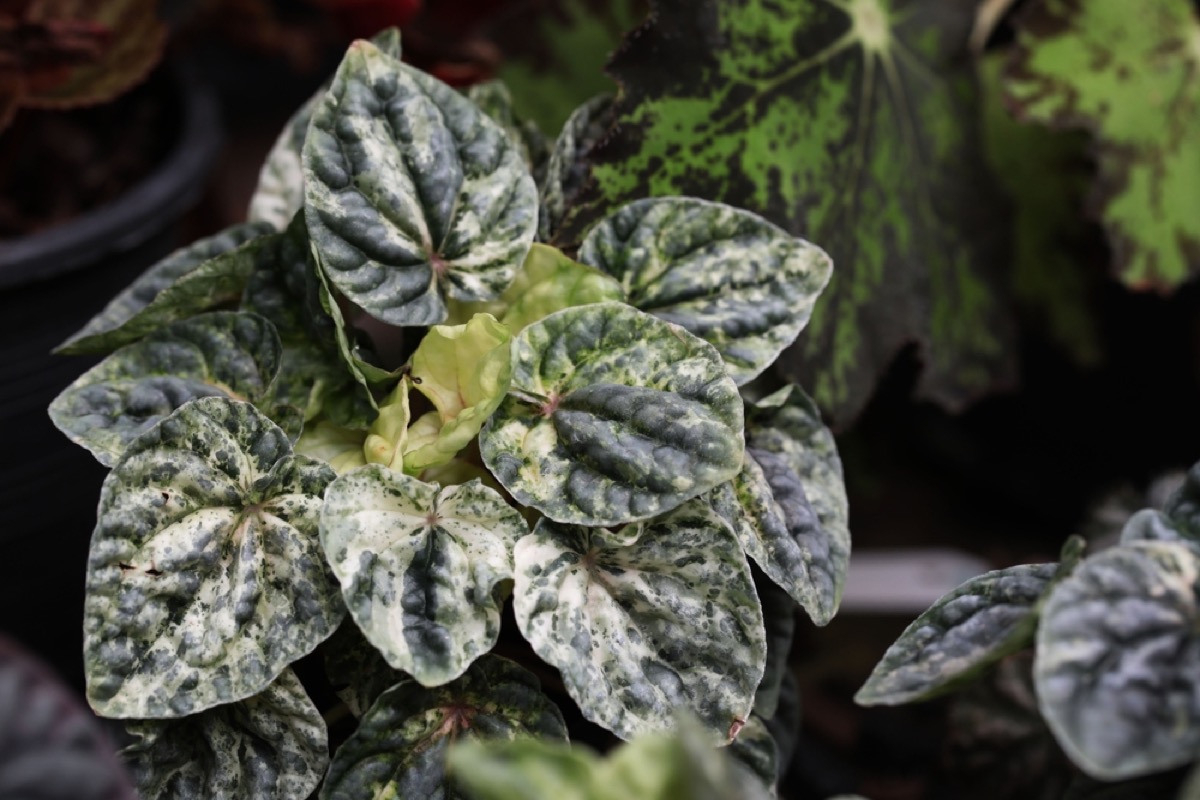Emerald Ripple Peperomia, also known as Peperomia caperata, is a popular houseplant that adds a touch of tropical charm to any room. This plant is native to the jungles of South America and typically grows as a groundcover or epiphyte, thriving under the dense canopy. One of the key factors in keeping this plant healthy and vibrant is meeting its light requirements, which are quite different from many other common houseplants.
To provide optimal lighting conditions for an Emerald Ripple Peperomia, it’s essential to recreate the filtered light found in its natural habitat. The plant thrives in medium to bright light, but it’s crucial to protect it from direct sunlight, as the intense rays can cause damage to the delicate foliage. When placing your plant indoors, an east-facing windowsill in a bright room is ideal, while south- or west-facing windows may require the use of a sheer curtain to diffuse the sunlight.
In addition to its light requirements, Emerald Ripple Peperomia also needs a well-aerated potting medium and consistent watering to mimic the natural conditions found in the tropics. By providing the right balance of light and other environmental factors, you can ensure that your Emerald Ripple Peperomia flourishes and enhances your living space with its unique, captivating beauty.
Emerald Ripple Peperomia Overview
Emerald Ripple Peperomia, scientifically known as Peperomia caperata, is a popular houseplant originating from the jungles of South America. Belonging to the Piperaceae (pepper) family, this tropical plant is cherished for its attractive foliage and easy care.
One of the key features of the Emerald Ripple Peperomia is its stunning leaves, which are characterized by their deep green color, waxy texture, and unique rippled pattern. As an evergreen herbaceous groundcover, this plant typically grows up to 8 inches tall, making it the perfect choice for home gardens or indoor spaces with limited space.
When considering light requirements for the Emerald Ripple Peperomia, it is important to remember that the plant thrives in medium to bright light. However, direct sunlight must be avoided as it can cause damage to the plant’s waxy leaves. To achieve optimal growth, choose an east-facing windowsill in a room with ample brightness. If your only option is a south- or west-facing window, ensure that you filter the sunlight through a sheer curtain to prevent any scorching.
In terms of care, it’s crucial to provide the right balance of water and humidity. To maintain the plant’s health, you should:
- Allow the top 4-5 inches of soil to dry out completely between waterings
- Water more sparingly during winter months
- Keep the plant in light shade or bright indirect light
By providing the appropriate light conditions and care, you can enjoy the stunning foliage of the Emerald Ripple Peperomia for years to come.
Light Requirements for Growth and Health
Ideal Light Conditions
Emerald Ripple Peperomia (Peperomia caperata) thrives in bright, indirect light provided by a west or east-facing window. They can also grow well under fluorescent lights. These plants require sufficient light for photosynthesis, an essential process for their survival and optimal growth. Ideally, they should be placed in an east-facing window sill for the best lighting conditions. Note that direct sunlight can harm the leaves, so it’s essential to ensure they get the right amount of light but not too much.
Signs of Inadequate Lighting
Inadequate light can result in several issues for your Emerald Ripple Peperomia. For instance, insufficient light may cause slow or no growth at all. Additionally, the plant may appear to be stretching or reaching towards the light source, which is known as etiolation. Leaves may also become pale and lose their vibrant green color. To address this problem, try moving your plant closer to a bright, indirect light source or providing artificial light when necessary.
Signs of Excessive Lighting
Too much light, particularly direct sunlight, can also harm your Emerald Ripple Peperomia. Signs of excessive lighting include burnt or scorched leaves. The plant may also show signs of stress, such as withering or dropping leaves. To address this issue, move the plant to a shadier location or place it behind a sheer curtain that can filter and diffuse the intense sunlight. Remember to monitor your plant’s health and adjust its location as needed to ensure it receives the right balance of light.
Adapting to Different Light Conditions
Emerald Ripple Peperomia, also known as Peperomia caperata, is a beautiful houseplant that is known for its adaptable nature. When it comes to light requirements, this plant thrives best under medium light conditions such as sun filtered through a thin curtain. However, they can also tolerate low light conditions for several months.
If you’re growing your Emerald Ripple Peperomia indoors, try to provide it with bright indirect light. Placing it near a north or east-facing window will usually ensure the right amount of light. In case the plant starts showing signs of slow or no growth, consider changing its position to somewhere with better light conditions.
Outdoor growers should keep in mind that these tropical plants usually fare better in partial shade. The ideal temperature range for optimal growth is between 65°F to 75°F, so choose a spot in your backyard that fulfills these conditions, preferably in USDA hardiness zones 10-12.
Lastly, here are some useful tips for maintaining the right light conditions for your Emerald Ripple Peperomia:
- Rotate the plant regularly to ensure all sides receive equal light exposure.
- Avoid direct sunlight as it can cause leaf burn and scorching.
- Use artificial light sources like fluorescent lights if natural light isn’t available.
By following these guidelines, you’ll be able to keep your Emerald Ripple Peperomia healthy and happy under various light conditions.
Additional Care Requirements
Watering
Emerald Ripple Peperomia prefers a well-draining soil in a pot that offers ample drainage. Allow the top 4-5 inches of soil to completely dry out between watering sessions. To avoid overwatering, it’s a good idea to water more sparingly during the winter months, as plant growth slows down.
Temperature
As tropical plants, Emerald Ripple Peperomia enjoys a warmer environment, with temperatures ranging between 65°F and 75°F. These plants typically thrive in USDA hardiness zones 10-12. Keep in mind that they need to be protected from cold drafts and sudden temperature fluctuations.
Fertilizing
In general, Peperomia plants don’t require frequent fertilizing. It’s advisable to apply a diluted liquid fertilizer once every few months during the growing season (spring and summer). Avoid feeding your plants during the dormant period in winter, as it can lead to unnecessary stress on the plant.
Common Problems and Solutions
Pest and Disease Issues
Emerald Ripple Peperomia plants may sometimes encounter issues with pests and diseases. Common pests that can affect these plants are mealybugs, spider mites, and fungus gnats. To prevent these pests, ensure the plant is kept clean and remove any dead leaves or debris promptly. In case of a pest infestation, use an insecticidal soap or neem oil to treat the plant. Avoid overwatering, as this can lead to fungal diseases like root rot. Make sure the soil has good drainage and dries out between waterings to discourage fungal growth.
Growth and Foliage Problems
Improper lighting conditions are a common cause of growth and foliage problems in Emerald Ripple Peperomia plants. These plants thrive in medium to bright light, protected from direct sunlight. If the plant experiences slow or no growth, it might be due to insufficient light exposure. To resolve this issue, move the plant to a location with better-suited lighting conditions.
Another common problem with these plants is yellowing or dropping leaves. This often occurs due to overwatering or underwatering. Allow the top 4-5 inches of soil to dry out completely between waterings and adjust the watering schedule as needed to maintain healthy foliage.
Here are some tips to keep your Emerald Ripple Peperomia healthy:
- Provide medium to bright, indirect light
-
It is recommended to let the top 4-5 inches of soil dry out before watering again.
- Keep the plant in temperatures between 60-80˚F (15-26˚C)
- Ensure the potting mix is well-draining and aerated
By addressing these pest, disease, and growth issues, you can better care for your Emerald Ripple Peperomia and enjoy its vibrant foliage year-round.
Propagation Tips and Techniques
Emerald Ripple Peperomia, also known as Peperomia caperata, is a popular houseplant that is easy to propagate using various methods. In the following paragraphs, you’ll find several techniques to help you propagate your Emerald Ripple Peperomia.
One of the simplest ways to propagate this plant is through stem and leaf cuttings. To do this, cut a stem or leaf from the plant, ensuring that there’s at least one node on the stem. Remove the lower leaves, keeping one or two mature leaves at the top. Stick these cuttings directly in moist potting mix and wait for a few weeks until they root.
Another method to consider is propagating peperomia in water. This technique is similar to propagating pothos and is recommended due to its ease. Remember to capture a node or growth point within the cutting. Place the cuttings with their bottom end submerged in water and wait for roots to appear. Once a healthy root system has developed, transfer the cutting to a small pot with well-draining soil.
When potting your newly rooted Emerald Ripple Peperomia, use a high-quality potting mix designed for houseplants. Dig a small hole in the soil, place your plant, and backfill with more soil. Tamp down lightly and water thoroughly to ensure the plant establishes well.
For the best results, provide your Emerald Ripple Peperomia with medium light conditions like sunlight filtered through a thin curtain. Adequate light is essential for the healthy growth of this tropical plant.
In summary, propagating Emerald Ripple Peperomia can be easy and rewarding using various techniques, such as stem and leaf cuttings or water propagation. Ensure that you provide your newly propagated plants with the right conditions, such as well-draining soil and medium light, for optimal growth.
Conclusion
Emerald ripple peperomia (Peperomia caperata) is a beautiful and easy-to-grow houseplant that thrives in medium to bright light. It is important to protect this plant from direct sun exposure, as it can cause damage to its waxy leaves. In order to achieve the best lighting conditions, you may consider the following:
- Place the plant near an east-facing window to receive ample bright light throughout the day.
- If positioned near a south- or west-facing window, use a sheer curtain to filter sunlight, preventing damage to the leaves.
- For optimal outdoor lighting, choose partial shade to ensure the plant doesn’t receive too much intense sun.
Following these guidelines will allow your emerald ripple peperomia to grow happily and healthily. Remember to also water the plant appropriately, allowing the top 4-5 inches of soil to dry out completely between waterings. During colder months, decrease the frequency of waterings, as the plant requires less moisture during its resting phase.
By understanding your emerald ripple peperomia’s lighting needs and combining them with proper watering techniques, this stunning tropical plant will undoubtedly flourish in your home, creating a visually appealing addition to your indoor garden.
Helpful Video

My name is Daniel Elrod, and I have been houseplant love ever since I was 17. I love how much joy they bring to any room in the home. I’ve always been amazed at how a few pots of flowing leaves can turn a drab and sterile office into an inviting place where people love to work at.










































































































































































